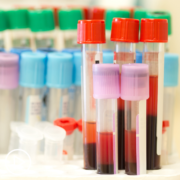What Are Some Clinical Myeloma Relapse Predictors?
What Are Some Clinical Myeloma Relapse Predictors? from Patient Empowerment Network on Vimeo.
Some multiple myeloma patients may relapse, but are there clinical predictors for relapse? Dr. Sikander Ailawadhi from the Mayo Clinic discusses mutations, clinical responses, and test results that may signal a higher likelihood of relapse.
See More from START HERE Myeloma
Related Programs:

|

|

|
Transcript:
Lisa Hatfield:
Great, what are some of the clinical predictors for relapse in myeloma and when should patients speak up?
Dr. Sikander Ailawadhi:
Okay, so when we say clinical predictors of relapse, well, let me look at this from the standpoint of a patient’s been diagnosed, they’ve been treated, which patients are more likely to relapse is one way of looking at, and if we are looking for our following up a patient, what are we monitoring to look for relapse? So I’ll address mutates very quickly. So when we say what are the predictors of earlier relapse, the most important things that we know of are on any of the high-risk communications we’ve been talking about, the fact that it’s standard of care to look for any genetic mutations in the center diseased plasma.
So the myeloma cells, presence of any high-risk mutations, for example, there’s one called deletion 17p to certain chromosome mutations like 14;16 translocation, etcetera. Patients should be aware of what mutations their plasma cells have, having high-risk mutations, risk of early relapse or short duration of response.
Similarly, if a patient does not get a deep response to their prior treatment, they are more likely to come out of that response state sooner. One of the tests that has recently been used over the past few years, there’s something called the MRD test, minimal residual disease test, looking for one myeloma cell out of 100,000 or even one million bone bone marrow cells.
If somebody’s MRD-negative, they are more likely to have a longer duration of response. If they’re MRD-positive, meaning detectable disease on MRD test, comparatively shorter duration of response, etcetera. So these are predictors of earlier relapse, there are some other predictors like kidney dysfunction, and typically that happens if somebody has persistent kidney dysfunction because they don’t typically get access to all the drugs, typically relapse occurs sooner.
Now, when somebody is getting monitored for their disease, as I mentioned, we do labs every so frequently every month, every two months, every three months. That is what involves all the myeloma markers, serum lectrophoresis is to look for M spike, free light chains, look for light chain changes. You see what I mean? We know globules look for increases in immunoglobulins, and that’s what helps pick up the recurrence of the disease.



